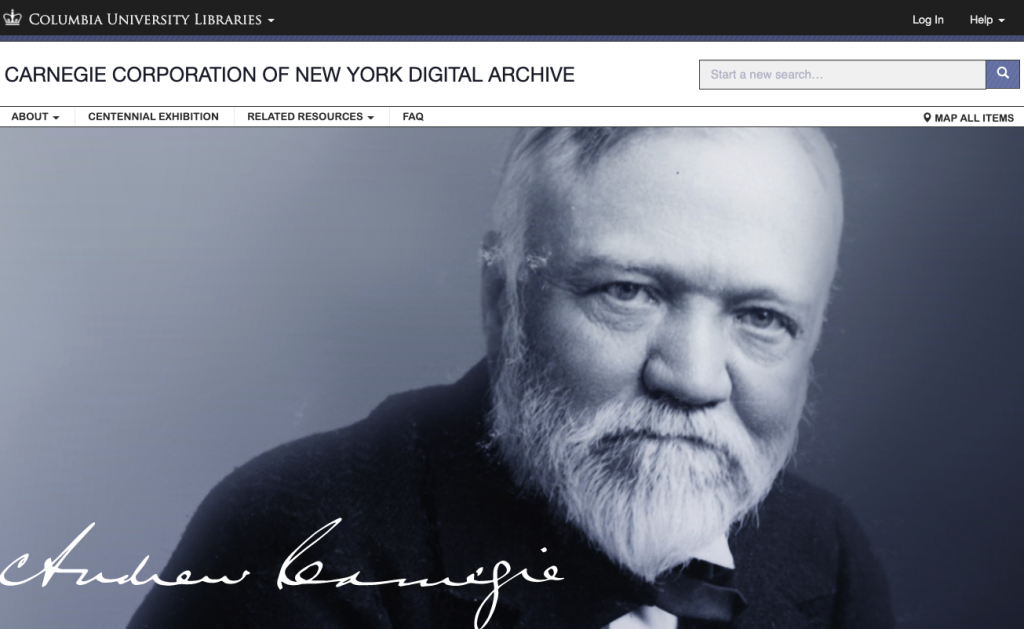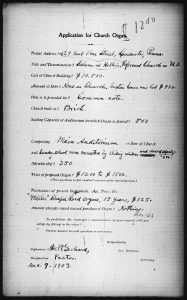Carnegie Corporation Archivist Jennifer Comins announces a project a long-time in the making and recently completed, the Carnegie Corporation of New York Digital Archive. In this post, she offers insights into the various pathways to using this vast collection, recently completed with the help of a major grant from the Corporation.

The updated Carnegie Corporation of New York finding aid, along with the newly released Carnegie Corporation of New York Digital Archive is a breath of fresh air.
The Corporation, founded in 1911, has been granting projects within its mission for over 100 years. The records are vast and touch on many different subjects, people, and institutions. These materials will appeal to researchers in just about any field of study, but especially genealogy, philanthropy, the history of education, social science, international peace and security, and democracy.
For example, Carnegie donated libraries, both public and academic, and church organs all over the world. I did a personal search on the Digital Archive website using the map feature — fun is an understatement — checking Leavenworth, Kansas and Xenia, Ohio where my maternal grandparents were born. Sure enough, there were both a Carnegie Library and church organ donation in both towns.

Series II. Files on Microfilm. II.A. Gifts and Grants. II.A.3. Church Organs
I also searched Lancaster, Pennsylvania, where my paternal grandfather had a home. I have memories of being a child running amok in the vast fields. One day, when I was 5 years-old, I picked up what appeared to be a black and white kitten, which turned out to be a skunk! What I did not remember was that there was a Carnegie-donated church organ. On this particular organ donation, there are 150+ pages of intrigue.
Anyone can and will find documents in this collection that will resonate on some level, be it personal, professional or otherwise. A few examples that were Corporation-funded are the Children’s Television Workshop, including Sesame Street and the Electric Company, the Institute for International Education (IIE), the Fulbright Scholarship, National Bureau of Economic Research, National Academy of Science/National Research Council, Brookings Institution, and the Teachers Insurance and Annuity Association of America (TIAA).
Searching the new archive these are some of the gems I found:
- Dinosaur digs for the Carnegie Museum—need I say more?
- A brief history of the Halifax Explosion in 1917 when a Norwegian vessel collided with a French cargo ship carrying high explosives in the upper The explosion killed 2,000 people and caused massive damage to various buildings including Dalhousie University which the Corporation would rescue by paying the cost of repairs.
- This clip from the popular educational program Reading Rainbow featuring host LeVar Burton helping young viewers understand the creation of media illusions.
- Andrew Carnegie was President for some years of The Philharmonic Society, and built Carnegie Hall, which opened in 1891, specifically for the orchestra.
- The Alleghany Observatory, which opened in 1861, had to be moved in the late 19th century due to smoke from growing industries that obscured the sky and made it difficult to conduct research. A campaign started to build a new and larger observatory far from this industrial site. In 1899, Andrew Carnegie donated $20k, Charles M. Schwab donated the steel and George Westinghouse, the electrical installation. Henry Clay Frick donated the balance needed and now the observatory is part of the University of Pittsburgh. The observatory is considered a world leader in the study of stars since the 1860s and the birthplace of physics.
Browse the Carnegie Digital Archives Collection today!